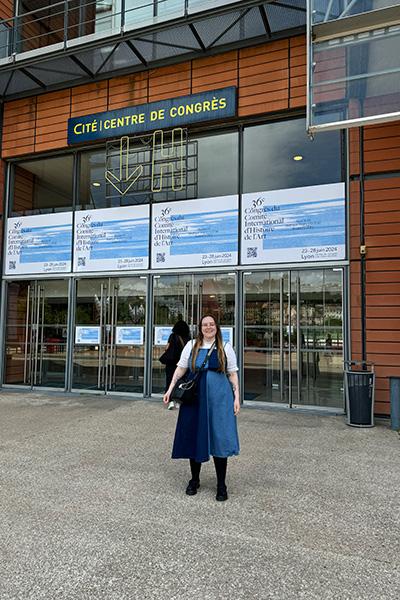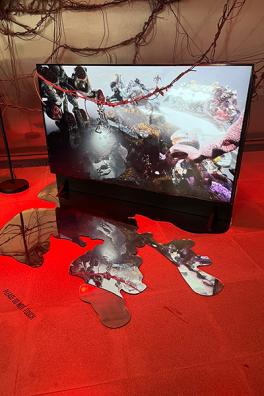
Tell us about your current research. What are the main questions that you are exploring in your dissertation?
I’m currently researching the most recent rise of finance capitalism, under which work has become more game-like and games mirror the demands of maintaining daily life, and artist-produced games that take place both on and off screen. This includes video games created between the 1980s and the present and more canonical participatory artworks from the 1960s to 1990s by Allan Kaprow, Joseph Beuys and Santiago Sierra. Although art video games are arguably the primary form of participatory art in the present, in that they respond to the most popular entertainment medium of our time, scholars typically discuss them in isolation from larger histories of participatory art. In my dissertation, I aim to consider digital and physical art games in conversation with each other because several artworks of both forms respond to the gaming logics central to finance capitalism, which, although amplified through video gaming, already saturated lived space before artists gained widespread access to new gaming technologies. Throughout my dissertation, I will question how, as action-based mediums, art games might offer effective critiques by moving beyond representation alone and requiring time and labor from their participants. How might they allow players to act out potential alternatives to their current relations to power and challenge the seemingly natural spread of game dynamics like liquidity, flexibility, quantification, flow and presumed rationality beyond the screen?
You have traveled to see a number of museum shows over the past couple of years in order to see works you are writing about. Can you share a few highlights?
Last summer, I traveled to London to see Gabriel Massan’s exhibition Third World: The Bottom Dimension at Serpentine North. While one can download the main video game featured in this show for free online, visiting the exhibition in person allowed me to observe others playing the game, experiment with collaborative forms of gameplay, and participate in an NFT minting experience exclusive to the gallery space. Although Massan’s game was also featured in Worldbuilding: Gaming and Art in the Digital Age, another exhibition I saw last summer at the Centre Pompidou-Metz in France, it was not displayed in a playable format, so I was grateful I got to engage with the full experience in London, as I will be writing about this artwork in my dissertation. I still had an amazing time seeing Worldbuilding, though, as it featured over fifty artworks from the 1990s to present that use video games as their form and/or content, many of which are not accessible online.
A major highlight from this year was traveling to New York City to see the Museum of Modern Art’s recent installation of Michael Smith’s Government Approved Home Fallout Shelter Snack Bar (1983). For this installation, Smith produced one of the first art video games, Mike Builds a Shelter, and placed it outside of a room designed to appear as a basement with a snack bar that can serve as a fallout shelter. At MoMA, I spent several hours playing the arcade game, watching the video Smith created to be displayed on the television in the shelter, and taking in the small details of the installation, such as the board games in the closet and books and pamphlets on the shelves.

In July, I traveled to Kassel, Germany, to see Joseph Beuys’s 7000 Oaks (1982). As part of documenta 7, Beuys initiated the planting of 7,000 oak trees accompanied by basalt columns in Kassel over a five-year period. During my visit, I walked around the city to find various sites where the trees were planted and spent time researching the project at documenta archiv. I then traveled to Bedburg-Hau, where the Museum Schloss Moyland houses the Joseph Beuys Archive. To my surprise, the museum had just opened an exhibition titled The Earth Does Not Need Us by the artist collective The Institute of Queer Ecology (IQECO) responding to 7000 Oaks. Before I knew about this exhibition, I was already planning to write a dissertation chapter in which I analyze 7000 Oaks in relation to Massan’s Third World and an art game produced by IQECO, so I’m even more excited to do so now!
You won a fellowship to attend the 2024 CIHA (Comité International d’Histoire de l’Art) Conference in Lyon, France in June. What was the conference like? How was the theme of “Matter / Materiality” being approached?
This was my first time attending an international conference, and, at first, I was a little overwhelmed by the scale, as there were 1,650 attendees and 93 sessions. However, having the opportunity to reconnect with some of my former professors and old friends in the beautiful city of Lyon made the conference feel much more approachable. I also appreciated that the National Committee for the History of Art hosted a dinner for its fellowship recipients, as I was able to engage with the board members and fellow grad students from around the country.
The theme “Matter / Materiality” was approached from many different angles. I attended panels with topics ranging from the materiality of the internet and the queering of materiality to the simulation of materials in European painting between the 15th and 17th centuries. Some of the most intriguing presentations took on creative formats, such as a projected graphic novel exploring the topic of “critical zones” and a performance to encourage the formation of kinship with rocks. The keynotes also offered great variety, as the novelist Orhan Pamuk gave the opening lecture, and Georges Didi-Huberman and the artist Jefferson Pinder gave the closing talks. For me, the most engaging event was the conversation held between the anthropologist Tim Ingold and the art historian Finbarr Barry Flood. The conversation began with a general overview of Ingold’s key concepts, such as the “meshwork,” but it ended with a mildly heated debate about whether or not it makes sense to attribute agency to humans and things and if people truly can or should be held accountable for their actions. Overall, I’m looking forward to attending the next CIHA, which will take place in Washington, DC, in 2028 with the theme “Sovereignty.”
April Riddle is a PhD Candidate in the History of Art Department.
